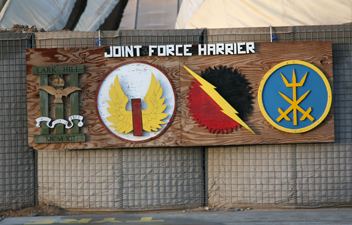Country United Kingdom | ||
 | ||
Active 1 April 2000 - 28 January 2011 Branch Ministry of Defence
- Royal Air Force
- Royal Navy Attack Sea Harrier FA2
Harrier GR7/7A
Harrier GR9/9A Engagements Operation Herrick, Operation Telic Similar Royal Air Force Germany, RAF Strike Command, Joint Helicopter Command, RAF Air Command, RAF Transport Command | ||
Joint force harrier in action in afghanistan
Joint Strike Wing, previously known as Joint Force Harrier (JFH), was the British military formation which controlled the STOVL BAE Harrier II aircraft of the Royal Air Force and Fleet Air Arm. It was sub-ordinate to RAF Air Command.
Contents
- Joint force harrier in action in afghanistan
- History
- Joint Force HarrierJoint Strike Wing units
- References
Upon its disbandment there were two operational Joint Strike Wing squadrons, one Fleet Air Arm and one Royal Air Force, plus an RAF Operational Conversion Unit.
History
Joint Force Harrier (JFH) was established on 1 April 2000 in response to the proposal brought by the British Government as part of Strategic Defence Review. Originally called Joint Force 2000, it combined the Royal Navy's two Sea Harrier FA2 squadrons with the RAF's four Harrier GR7/7A squadrons under a single command structure within RAF Strike Command. This force was to be deployable from both Invincible class aircraft carriers, Royal Air Force stations and deployed air bases.
The Royal Navy's contribution to the force was the Sea Harrier previously part of Naval Air Command. .
In 2006, No. 3 Squadron RAF converted to the Eurofighter Typhoon. In the same year, the Sea Harrier was retired and 800 Naval Air Squadron re-equipped with former 3 Squadron Harrier GR7 and GR9 aircraft. At the same time, the size of operational squadrons reduced from 12 aircraft to nine. The Naval Air Squadron operated but did not own the aircraft.
801 Naval Air Squadron was also intended to reform with Harrier GR7/9s in 2007. However, on 9 March 2007, the Naval Strike Wing (NSW) was formed. This saw elements of both Fleet Air Arm squadrons amalgamate into a single operational squadron for deployment either on land (such as Afghanistan) or aboard the Royal Navy's two aircraft carriers (HMS Illustrious & HMS Ark Royal) On 1 April 2010, NSW reverted to the identity of 800 Naval Air Squadron.
On 31 March 2010, the force was reduced by one squadron with the disbandment of No. 20 Squadron RAF, the Harrier Operational Conversion Unit (OCU). No. 4 Squadron also disbanded and reformed as No. 4 (Reserve) Squadron at RAF Wittering, taking over as the OCU. At the same time, Joint Force Harrier was renamed Joint Strike Wing and all remaining Harrier GR7 aircraft were retired.
Until 2010, it was intended that the Harrier GR9 fleet would continue in service until replaced by 138 STOVL-capable F-35B Lightning II aircraft around 2018. However, on 19 October 2010, as part of the UK government's Strategic Defence and Security Review, it was announced that the Harrier out-of-service date was to be brought forward to April 2011.
HMS Ark Royal, the final Royal Navy strike carrier, launched her final fixed wing aircraft on 24 November 2010 when the four embarked Harrier GR9s left the ship to return to land. On 15 December 2010, a 16 aircraft flypast from RAF Cottesmore marked the final operational flights of British Harriers. 1(F) Squadron, 4(R) Squadron and 800 NAS were disbanded on 28 January 2011.
